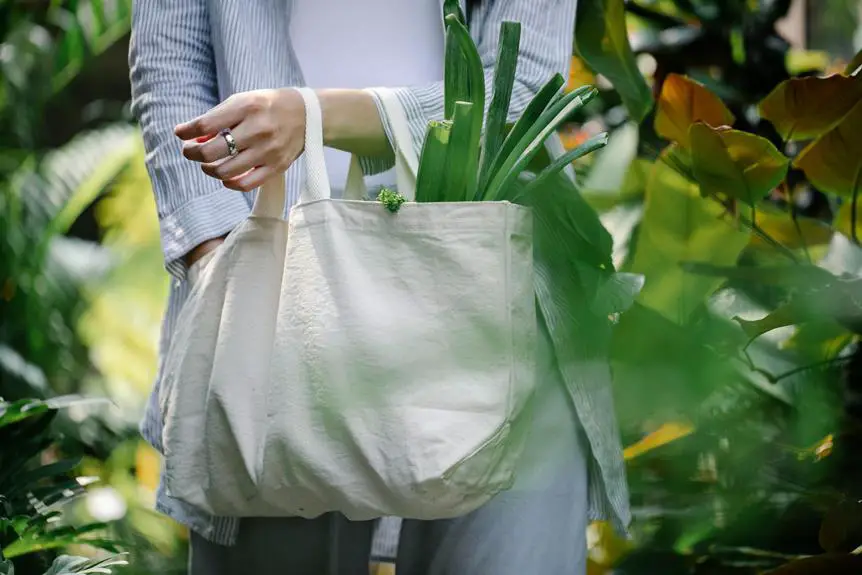You might be wondering whether hemp fabric truly lives up to its eco-friendly reputation, particularly when it comes to biodegradability and disposal methods. Unlike synthetic fabrics, hemp breaks down relatively quickly, which is a significant advantage for sustainable practices. But what about the actual process of disposal? Are there specific methods that maximize its environmental benefits? Understanding these aspects can help you make more informed choices about your fabric options. Let's explore the nuances of hemp fabric's lifecycle and its impact on our planet.
Table of Contents
Key Takeaways
- Hemp fabric is biodegradable, breaking down in months to a couple of years, thanks to its high cellulose content.
- Composting hemp fabric enriches soil and minimizes landfill waste, making it an eco-friendly disposal method.
- Recycling hemp fabric is an option, with many local centers and initiatives available for sustainable disposal.
- Untreated hemp fabric decomposes more efficiently than treated fabric, enhancing its environmental benefits.
Understanding Hemp Fabric
Hemp fabric is a versatile material made from the fibers of the hemp plant, known for its durability and eco-friendly properties. When you choose hemp fabric, you're opting for a strong, long-lasting material that can withstand wear and tear better than many other fabrics. Its natural fibers aren't only resilient; they also have a unique texture that can feel soft against your skin.
You might appreciate hemp's breathability, making it an excellent choice for clothing, especially in warm weather. Unlike synthetic materials, hemp allows air to circulate, helping keep you comfortable. Additionally, the fabric has natural moisture-wicking abilities, which means it can pull moisture away from your body, keeping you dry.
Hemp fabric is also resistant to mold and UV rays, adding to its practicality. You'll find it used in various products, from clothing and accessories to home textiles like curtains and upholstery.
With its low environmental impact and ability to be grown without harmful pesticides, hemp fabric stands out as a sustainable option. When you're looking for a fabric that combines functionality with eco-friendliness, hemp should be at the top of your list.
The Biodegradability of Hemp
When you think about hemp, consider its natural fiber composition and how that influences its biodegradability.
You'll find that understanding the decomposition process is key to appreciating its environmental impact.
Let's explore how these factors come together to make hemp a sustainable choice.
Natural Fiber Composition
Natural fibers like hemp are known for their impressive biodegradability, making them an eco-friendly choice for sustainable textiles. When you choose hemp fabric, you're opting for a material that breaks down naturally over time, returning nutrients to the soil. This process is a direct result of its natural fiber composition, which consists primarily of cellulose, hemicellulose, and lignin. These components are organic and easily digestible for microorganisms.
Unlike synthetic fibers, which can take hundreds of years to decompose, hemp fabric can break down within a few months to a couple of years, depending on environmental conditions. The high cellulose content in hemp contributes significantly to its ability to decompose efficiently. When exposed to moisture, heat, and microbial activity, hemp fibers begin to break apart, promoting a healthier ecosystem.
Moreover, hemp's natural properties resist pests and mold, reducing the need for harmful chemicals during its cultivation. This means you're not only choosing a biodegradable option but also supporting a more sustainable farming practice.
Decomposition Process Explained
The decomposition process of hemp fabric involves a series of interactions between microorganisms, moisture, and heat, leading to its rapid breakdown into organic matter. When you dispose of hemp fabric in a suitable environment, these conditions kick in.
Microorganisms, including bacteria and fungi, start to colonize the fabric. They break down the cellulose and lignin fibers, digesting the material and converting it into simpler compounds.
Moisture plays a critical role; it hydrates the microorganisms, enhancing their activity. Without enough moisture, the decomposition slows down significantly. Heat also accelerates the process, as warmer temperatures boost microbial metabolism.
In an ideal composting scenario, you'll notice that hemp fabric can decompose within a few months, depending on the environmental conditions. The fabric's natural fibers break down without leaving harmful residues, making it a sustainable choice for eco-conscious consumers.
Environmental Impact Assessment
Hemp fabric's biodegradability significantly reduces its environmental impact compared to synthetic alternatives, offering a sustainable option for eco-conscious consumers.
When you choose hemp, you're opting for a material that breaks down naturally, returning nutrients to the soil and minimizing landfill waste. This is crucial in a world where plastics and synthetic fibers persist for hundreds of years.
Unlike polyester and nylon, which can take decades to decompose, hemp fabric typically breaks down within a few months to a few years, depending on environmental conditions. This quick decomposition helps reduce the accumulation of waste in landfills and lowers greenhouse gas emissions associated with waste breakdown.
Moreover, hemp cultivation requires fewer pesticides and herbicides, making it less harmful to ecosystems.
Comparison With Other Fabrics
When comparing biodegradability, hemp fabric often outperforms synthetic options like polyester and nylon. These synthetic fabrics can take hundreds of years to decompose, contributing to long-term environmental damage. On the other hand, hemp fabric breaks down more quickly, typically within a few months to a few years, depending on environmental conditions.
You might also consider cotton, which is a natural fiber like hemp. While cotton is biodegradable, it requires significant water and pesticide use during cultivation, which can lead to soil degradation and water scarcity. Hemp, in contrast, grows with less water and without the need for harmful chemicals, making it a more sustainable choice overall.
Another fabric to think about is linen, derived from flax. Linen biodegrades similarly to hemp, but its production can be resource-intensive. So, if you're looking for an eco-friendly option, hemp fabric stands out not just for its biodegradability but also for its lower environmental impact during cultivation.
Factors Affecting Decomposition
Several factors influence how quickly hemp fabric decomposes in various environments.
First, moisture plays a crucial role; hemp thrives in wet conditions, where microorganisms can break it down faster. If you expose your hemp fabric to dry environments, decomposition slows significantly.
Temperature is another key factor. Warmer temperatures accelerate microbial activity, leading to quicker decomposition. Conversely, cool conditions can hinder this process. When you're considering disposal, think about the environment's temperature and humidity levels.
The presence of microorganisms also affects breakdown rates. In nutrient-rich soils, beneficial bacteria and fungi can expedite the decomposition of hemp, while sterile or nutrient-poor environments will slow down the process.
Lastly, the fabric's treatment matters. If your hemp has been treated with chemicals or dyes, those substances can inhibit microbial action and prolong the decomposition time. So, if you've got untreated hemp fabric, expect it to break down more efficiently than its chemically processed counterparts.
Understanding these factors can help you make informed decisions when it comes to disposing of hemp fabric in an environmentally friendly manner.
Eco-Friendly Disposal Methods
When it comes to disposing of hemp fabric, you've got some eco-friendly options to consider.
Composting is a great way to return the nutrients to the soil, while recycling can give your old fabric a new life.
Let's explore how you can make the most sustainable choices for hemp disposal.
Composting Hemp Fabric
Composting hemp fabric is a sustainable way to dispose of your textiles, ensuring they break down naturally and enrich the soil.
Hemp is a natural fiber that decomposes quickly, making it an excellent choice for composting. By composting your hemp textiles, you not only reduce landfill waste but also contribute to a healthier environment.
Here are some tips to effectively compost your hemp fabric:
- Cut into smaller pieces: Shredding the fabric helps speed up the decomposition process.
- Mix with green materials: Combine hemp with nitrogen-rich materials like kitchen scraps or grass clippings for a balanced compost.
- Maintain moisture: Keep your compost pile damp but not soggy, as moisture is vital for decomposition.
Recycling Options Available
Recycling hemp fabric offers a responsible way to reduce waste while promoting sustainability in the textile industry. By choosing to recycle, you help minimize the environmental impact of discarded textiles. There are several options available for recycling hemp fabric, making it easier for you to contribute to eco-friendly practices.
Here's a quick overview of recycling options:
| Option | Description |
|---|---|
| Local Recycling Centers | Many communities have textile recycling programs. Check for facilities that accept hemp fabric. |
| Donation | If your hemp items are still in good condition, consider donating them to local charities or thrift shops. |
| Upcycling Projects | Get creative! Transform old hemp fabric into new items, like bags or home décor, giving them a second life. |
Benefits of Hemp Fabric
Hemp fabric offers a range of benefits, including durability, breathability, and natural resistance to mold and UV light.
When you choose hemp, you're opting for a material that stands the test of time while providing comfort and protection. This eco-friendly option not only feels great against your skin but also supports sustainable practices.
Here are some key benefits of hemp fabric:
- Eco-Friendly: Hemp requires less water and no pesticides to grow, making it a sustainable choice.
- Hypoallergenic: Hemp fabric's natural properties make it resistant to allergens, perfect for sensitive skin.
- Strong and Durable: Known for its strength, hemp fabric becomes softer with each wash while maintaining its integrity.
Making Informed Choices
When considering sustainable materials for your wardrobe, it's essential to weigh the environmental impact and longevity of your choices. Hemp fabric stands out as an eco-friendly option due to its biodegradable nature and minimal resource requirements during production. By opting for hemp, you're supporting a crop that grows quickly, requires less water, and needs fewer pesticides compared to conventional cotton.
However, it's crucial to look beyond just the fabric. Think about the entire lifecycle of your clothing. Pay attention to the manufacturing processes, transportation methods, and even the care instructions for your garments. Choosing items made with sustainable practices ensures that your investment aligns with your eco-conscious values.
Also, consider the versatility of hemp. It can be blended with other materials to enhance durability, making it a long-lasting addition to your wardrobe. This not only reduces waste but also minimizes the need for frequent replacements.
Ultimately, making informed choices involves researching brands and understanding their commitment to sustainability. The more you know, the better decisions you can make, ensuring that your wardrobe reflects your values while contributing positively to the environment.
Frequently Asked Questions
Can Hemp Fabric Be Recycled Instead of Composted?
Yes, you can recycle hemp fabric instead of composting it. Many recycling centers accept natural fibers, so check with local facilities. By recycling, you help reduce waste and promote sustainable practices in your community.
How Does Hemp Fabric Affect Soil Health During Decomposition?
When hemp fabric decomposes, it enriches the soil by releasing nutrients. You'll notice improved soil health as beneficial microorganisms thrive, promoting a sustainable ecosystem. Its natural breakdown supports plant growth, enhancing overall environmental balance.
Are There Any Chemicals in Hemp Fabric Production?
Yes, there can be chemicals in hemp fabric production, like pesticides or solvents used during processing. It's essential to research brands and their practices to ensure you're choosing a more sustainable and eco-friendly option.
Is Organic Hemp Fabric More Biodegradable Than Conventional Hemp?
Organic hemp fabric's generally more biodegradable than conventional hemp because it's produced without synthetic chemicals. You'll find it breaks down more easily in nature, making it a better choice for environmentally-conscious consumers like you.
Can I Use Hemp Fabric for Home Gardening Projects?
Absolutely, you can use hemp fabric for home gardening projects! It's durable, breathable, and helps with soil retention. Plus, its natural properties discourage pests, making it a great choice for your garden's health and growth.
- How Does Ring Spun Cotton Affect Garment Fit and Shape Retention? - August 13, 2024
- What Are the Challenges in Producing Ring Spun Cotton? - August 13, 2024
- Is Ring Spun Cotton Suitable for Plus-Size Clothing? - August 13, 2024






